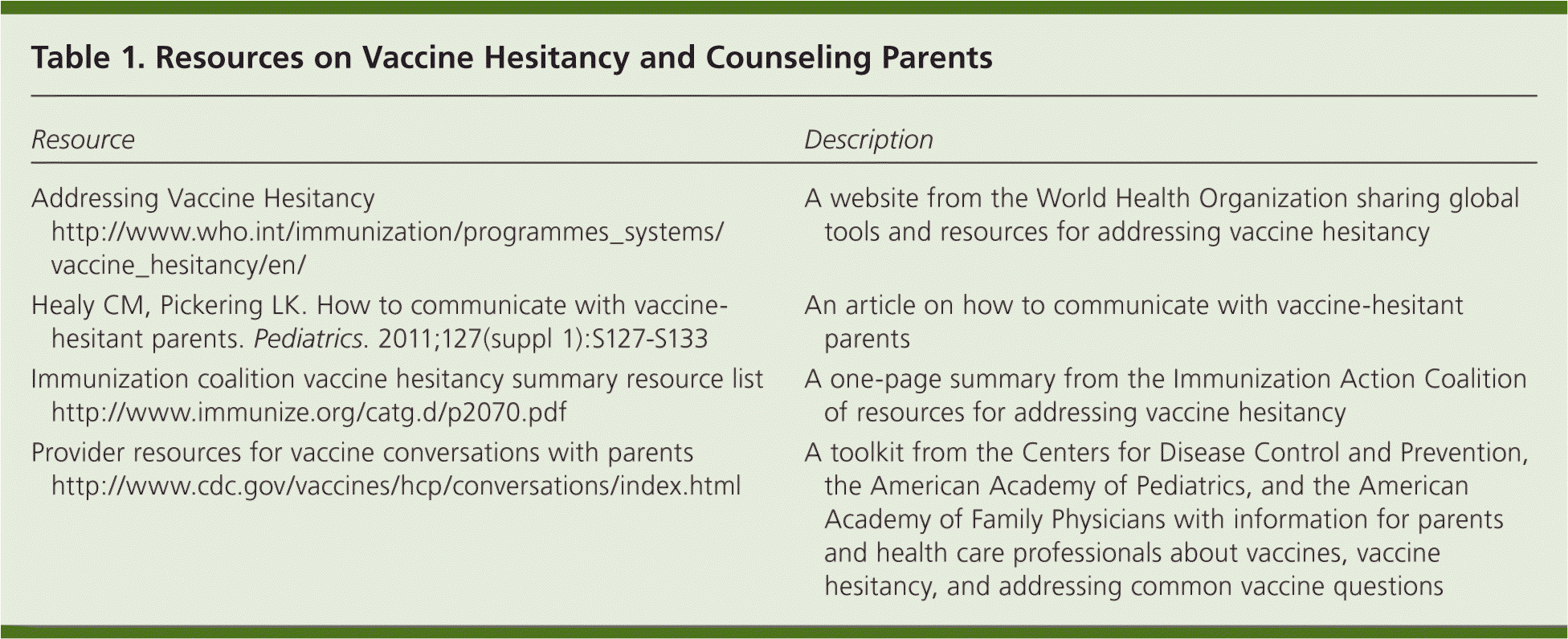
Am Fam Physician. 2016;94(2):94-96
Related letter: Conversations About Vaccines Should Underscore Their Public Health Benefits to Patients
Author disclosure: No relevant financial affiliations.
Every day across the United States, family physicians wrestle with how to best communicate to patients the clear benefits and potential harms of recommended vaccinations. When the current childhood immunization schedule is followed, it is estimated that 42,000 deaths and 20 million cases of disease are prevented annually.1 Additionally, from 2001 to 2010, vaccine use derived net savings of nearly $14 billion in direct costs and $69 billion in total societal costs.1 Because vaccines provide such overwhelming public health benefits, the American Academy of Family Physicians does not support nonmedical immunization exemption policies (https://www.aafp.org/about/policies/all/immunizations-exemptions.html).
Despite broad support for vaccination from the medical community, only 59% of children up to 18 years of age and 44% of adults were immunized against influenza during the 2014–2015 season.2 Although the Healthy People 2020 goal to have 90% immunization coverage in children for several vaccines has been met, only 72% of children were up-to-date on all of their vaccinations by three years of age.3 In some cases, low rates of immunization are a result of parental concerns and misconceptions. Physicians questioning how to effectively address these concerns can apply the following tips for reducing vaccine hesitancy.
Take Your Own Pulse
Physicians often approach discussions about vaccines anticipating pushback or disagreements that take valuable time to resolve. However, most patients, even ones who ask questions about vaccine safety, are not truly resistant to immunization, and parents largely want clarification and reassurance. Some persons will have specific safety concerns, and providing education that addresses these areas can lead them to follow your recommendations. Discuss vaccine safety in a nonjudgmental way by expressing curiosity, seeking first to understand before pressing to be understood.
Take Your Patient's Pulse
Cultural pressure, misinformation, and fear of harm are a few reasons why patients may hesitate to agree to vaccination. There are several published models on managing vaccine hesitancy, including the 3 C's (Confidence, Complacency, Convenience), the CASE approach (Corroborate, About me, Science, Explain/Advise), and the 3 A's (Ask, Acknowledge, Advise).4,5 Unfortunately, a recent Cochrane review of face-to-face interventions for addressing vaccine hesitancy found studies of their effects to be overall of low quality and generally lacking in impact.6 A cluster randomized controlled trial in Washington state, including 56 clinics and more than 300 mothers, showed that physician-targeted communication training had no detectable effect on vaccine hesitancy or physician communication.7 However, because patients may be less likely to trust physicians who communicate poorly, honing your motivational interviewing skills and practicing active listening does not take away from your ability to talk to patients about vaccine-related decisions.
Give a Strong Recommendation
What you say matters as much as how you say it. There are good data showing that a physician's recommendation is the most important reason a patient accepts an immunization.8,9 Opening the immunization conversation with a presumptive approach rather than a participatory approach (e.g., saying “We have to do some shots,” rather than asking, “What do you want to do about shots?”) can dramatically decrease resistance to vaccine recommendations. In one study, 83% of parents resisted recommendations with a participatory approach vs. only 26% with a presumptive approach, both in vaccine-hesitant parents and in the overall study population.10 Persistence matters. Nearly one-half of parents who initially resisted following immunization recommendations ultimately accepted them when physicians continued to pursue their recommendations.10 Conversely, a 2014 systematic review showed that a lack of a health care professional's recommendation was one of the top three reasons children did not get the human papillomavirus vaccine.11
Live to Fight Another Day
Despite all your best efforts, a small percentage of patients will refuse one or more vaccines. We encourage preserving your relationship with the patient and tabling the conversation for another day. In the United States, the parent or patient has the right to make medical decisions, and physicians should respect their decisions, even when they disagree.
The Centers for Disease Control and Prevention and the American Academy of Pediatrics recommend against asking patients or their families to leave your practice if they refuse to immunize.12,13 The rationale is that children need health care beyond immunizations, as well as a medical home. In addition, continuing care allows for an ongoing relationship, which might lead to parents being more willing to vaccinate in the future.
In summary, give strong, favorable vaccine recommendations. When faced with true hesitancy, be curious and ask respectful questions to delineate concerns. Remember that patients' ambivalence is your friend because it means that they have not closed their minds to vaccines. Explain your position and your knowledge of the subject, and recommend the vaccines again to reinforce the discussion. Then, leave the door open for further conversations. Table 1 lists several resources that provide additional information about counseling patients who are vaccine hesitant.

| Resource | Description | |
|---|---|---|
| Addressing Vaccine Hesitancy http://www.who.int/immunization/programmes_systems/vaccine_hesitancy/en/ | A website from the World Health Organization sharing global tools and resources for addressing vaccine hesitancy | |
| Healy CM, Pickering LK. How to communicate with vaccine-hesitant parents. Pediatrics. 2011;127(suppl 1):S127–S133 | An article on how to communicate with vaccine-hesitant parents | |
| Immunization coalition vaccine hesitancy summary resource list http://www.immunize.org/catg.d/p2070.pdf | A one-page summary from the Immunization Action Coalition of resources for addressing vaccine hesitancy | |
| Provider resources for vaccine conversations with parents http://www.cdc.gov/vaccines/hcp/conversations/index.html | A toolkit from the Centers for Disease Control and Prevention, the American Academy of Pediatrics, and the American Academy of Family Physicians with information for parents and health care professionals about vaccines, vaccine hesitancy, and addressing common vaccine questions | |
